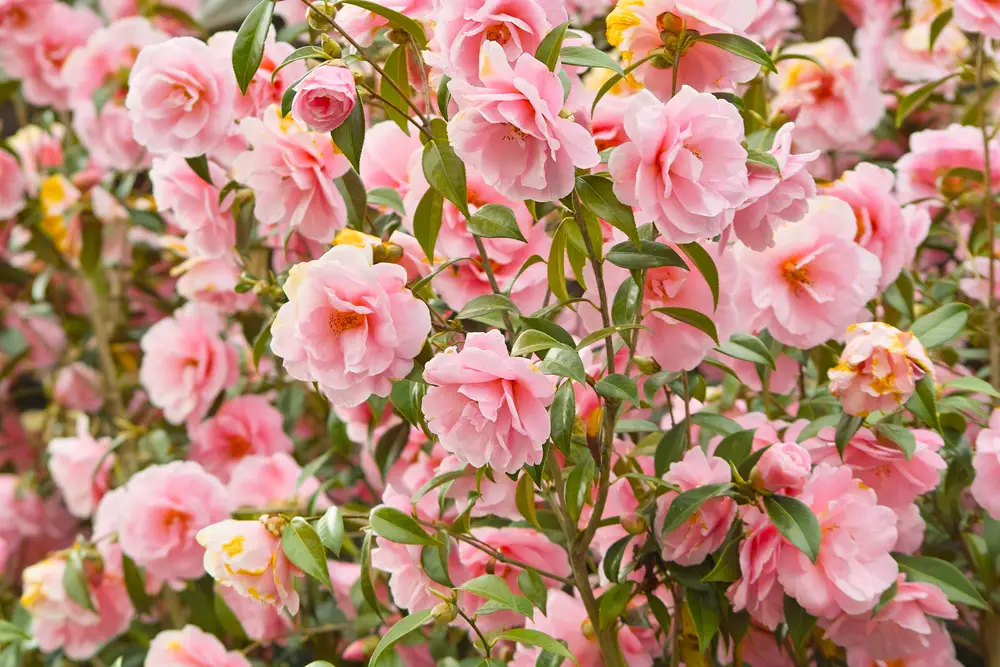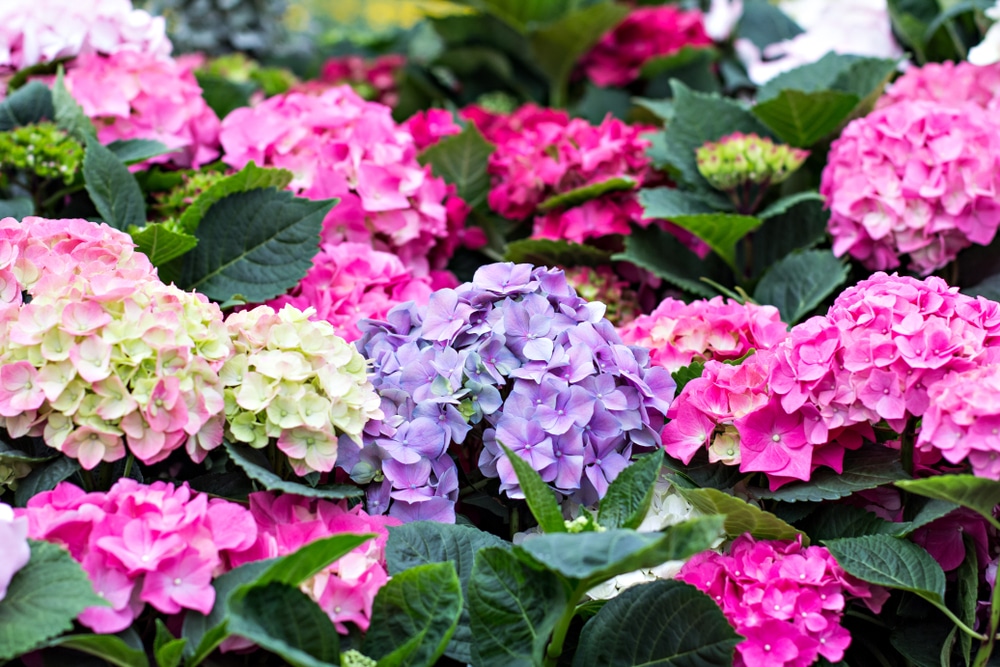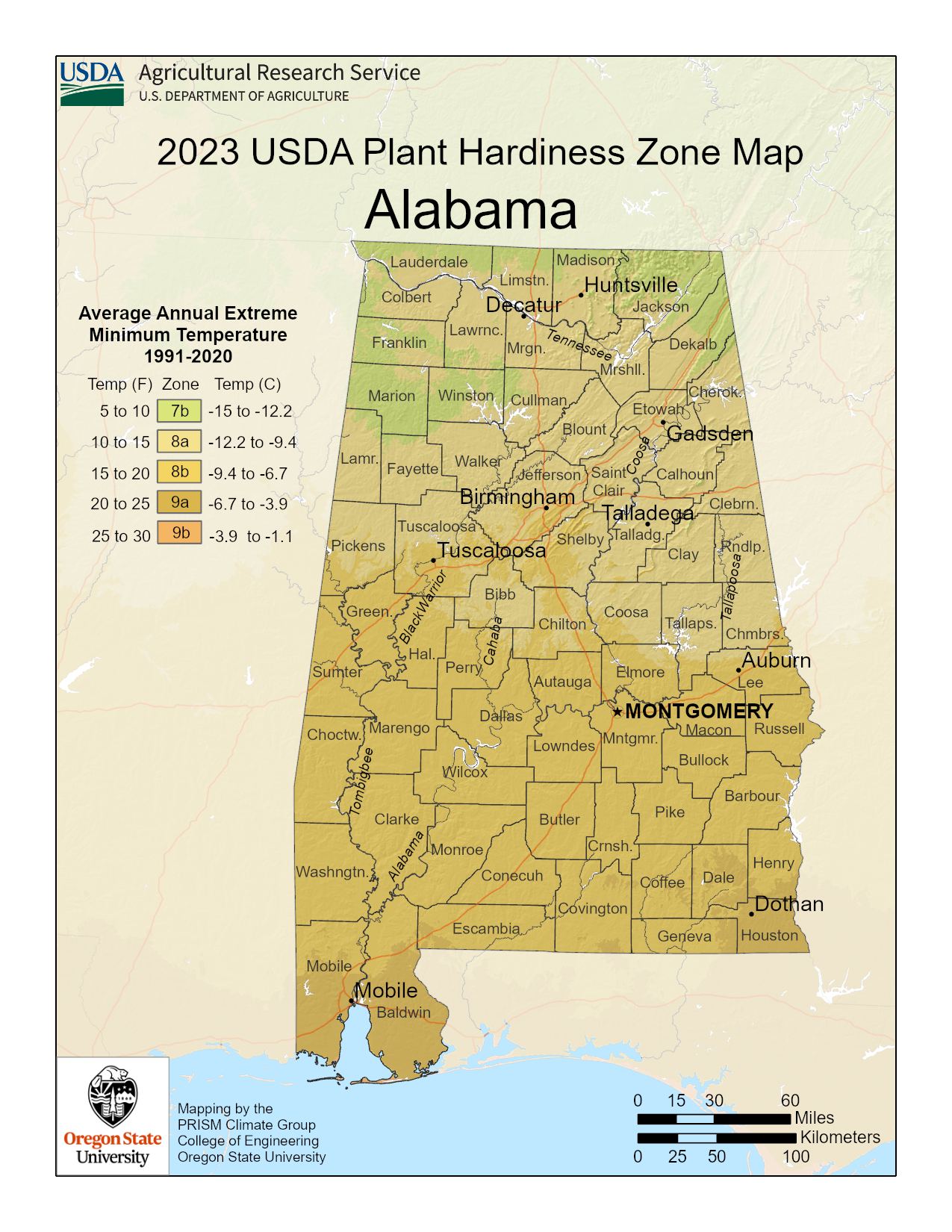Alabama Plant Hardiness Zones
| USDA Hardiness Zone | Average Minimum Extreme Winter Temperature Range Fahrenheit (°F) Celsius (°C) | Average Last Frost Date Range In Spring (Beginning Of The Growing Season) | Average First Frost Date Range In Autumn (End Of The Growing Season) |
|---|---|---|---|
| 7b | 5°F to 10°F -15°C to -12.2°C | Mid to late April | Mid to late October |
| 8a | 10°F to 15°F -12.2°C to -9.4°C | Mid-April | Late October to early November |
| 8b | 15°F to 20°F -9.4°C to -6.7°C | Early April | Early to mid-November |
| 9a | 20°F to 25°F -6.7°C to -3.9°C | Mid to late March | Early to mid-November |
| 9b | 25°F to 30°F -3.9°C to -1.1°C | Early to mid-March | Mid-November |
Alabama Growing Conditions

Credit to Wikipedia
General Climate
Alabama has a humid subtropical climate. Winters are relatively mild, summers are hot, and precipitation happens throughout all seasons.
Temperatures in the southern portion of the state are higher than in the north, partly due to the presence of the Appalachian mountain range.
Generally, humid subtropical climates:
- Often occur on the southeast part of continents
- Have long, hot, and humid summers
- Have cool winters, but the ground doesn’t freeze
- Their precipitation happens throughout the year
Microclimates
USDA plant hardiness zones are an important starting point for your garden, but you’ll also need to consider microclimates.
Microclimates are areas where specific conditions create a climate different from the climate they’re situated in.
Buildings, fences, paved areas, or short hills and valleys can create these microclimates.
They can be as small as a space in your backyard or as large as a city.
In other words, learn about your local conditions from local experts to see if your garden falls into a microclimate.
Extreme Weather
Tornadoes
Most tornado activity in Alabama is from late February to May and then again in November and December.
Beyond general storm preparation around your home, you cannot do much to protect your garden from tornadoes.
Once the storm has passed, prune away any damaged plant material as soon as possible.
Hurricanes
Due to its proximity to the Gulf of Mexico, Alabama regularly experiences hurricanes. The threat of hurricanes in Alabama peaks in August and September. However, hurricanes can hit the region anytime during the hurricane season (June to December).
These storms form overtop of warm ocean waters when rain storms circle a low-pressure area. The low pressure forces warm air just above the ocean to rise and move in a spiral.
As the warm air rises, it cools, and the moisture it carries condenses into clouds. If this process continues, it lifts increased amounts of air, and the spiraling wind intensifies. When wind speed within these storms reaches 74 miles per hour, it is officially a hurricane.
Hurricanes can cause devastating damage, and beyond general storm preparedness around your home, there is not a lot you can do to protect your garden from hurricanes.
Prune away any damage as soon as possible. Unless plants are obviously irreparably damaged, continue to assess. It will take a few days to fully understand your plants’ capacity to recover. Remove and replant as needed.
Flooding
Typically, hurricanes or severe thunderstorms cause flooding in Alabama. With areas receiving large amounts of precipitation at once, the water simply has nowhere to go.
To mitigate flooding in your garden, ensure effective drainage. You may also want to garden in raised beds or containers.
Growing Season
Alabama’s growing season runs from approximately March to November (depending on your specific growing region). The season is relatively long. It is also quite hot.
The conditions are perfect for heat-loving plants that need long periods of time to mature. However, you will need to be more strategic to grow plants that prefer cooler temperatures.
Alabama Gardening Tips

Choose The Right Plants
Alabama’s temperatures are suitable for a wide range of plants. However, the heat can create challenges.
Sowing early and harvesting crops that prefer moderate temperatures (such as peas, lettuce, spinach, etc.) before the heat peaks, and planting another succession in the fall, is one way to limit struggles.
Choosing locally adapted and heat-resistant varieties is also helpful.
Prevent Pests And Disease
Seek out plant varieties bred for disease resistance. They will have labels stating as such.
Use floating row cover to protect your transplants until they flower. At that time, remove them to allow for pollination.
Check on your plants daily or so for any indication of pests or disease. Address concerns (discolored leaves, holes, or apparent infestations) as quickly as possible.
Plant At The Right Time
Most gardeners would consider Alabama’s long and hot growing season a pleasure. However, those interested in growing plants that require cooler temperatures (such as lettuces, spinach, kale, broccoli, cauliflower, peas, and radishes) will need to plant these crops early to ensure harvest.
Waiting too long results in these plants setting seed before maturing, rendering them virtually inedible. This process is known as bolting.
To avoid bolting, plant as early in the season as possible. Another option is to also plant another succession of these crops in the autumn.
Water well and mulch around the base of these plants with a couple of inches of straw, finished compost, or grass clippings. This can stretch their capacity to withstand heat a little bit by keeping roots cooler than they would be closer to the surface.
Consult With Local Professionals
Consulting with local gardening professionals allows you to benefit from their experience with your area’s conditions, the plants that do well there, and overall best practices.
Alabama Plant Suggestions

Trees
- Red Maple (Acer rubrum)
- Southern Magnolia (Magnolia grandiflora)
- Box Elder (Acer negundo)
Shrubs
- Bottlebrush Buckeye (Aesculus parviflora)
- Alabama Azalea (Rhododendron alabamense)
- Oakleaf Hydrangea (Hydrangea quercifolia)
Flowers
- Swamp Mallow (Hibiscus coccineus)
- Passion vine (Passiflora incarnata)
- Butterfly weed (Asclepias tuberosa)
Vegetables
- Beans (Phaseolus vulgaris)
- Collards (Brassica oleracea, var. viridis)
- Okra (Abelmoschus esculentus)
Herbs
- Lemon Balm (Melissa officinalis)
- Mint (Mentha piperita)
- Dill (Anethum graveolens)
Spices
- Cayenne (Capsicum annuum, cayenne)
- Anise (Pimpinella anisum)
- Coriander (Coriandrum sativum)
Fruits
- Quince (Cydonia oblonga)
- Persimmon (Diospyros kaki)
- Pomegranate (Punica granatum)
Succulents
- Weak Leaf Yucca (Yucca flaccida)
- Aloe Vera (Aloe barbadensis miller)
- Purslane (Portulaca oleracea)
Disclaimer
Any of the above can change and is not exhaustive.
Treat anything above like a good starter guide. Then use that as a foundation as you consult with local gardeners, professionals, forecasts, guides, and organizations.

